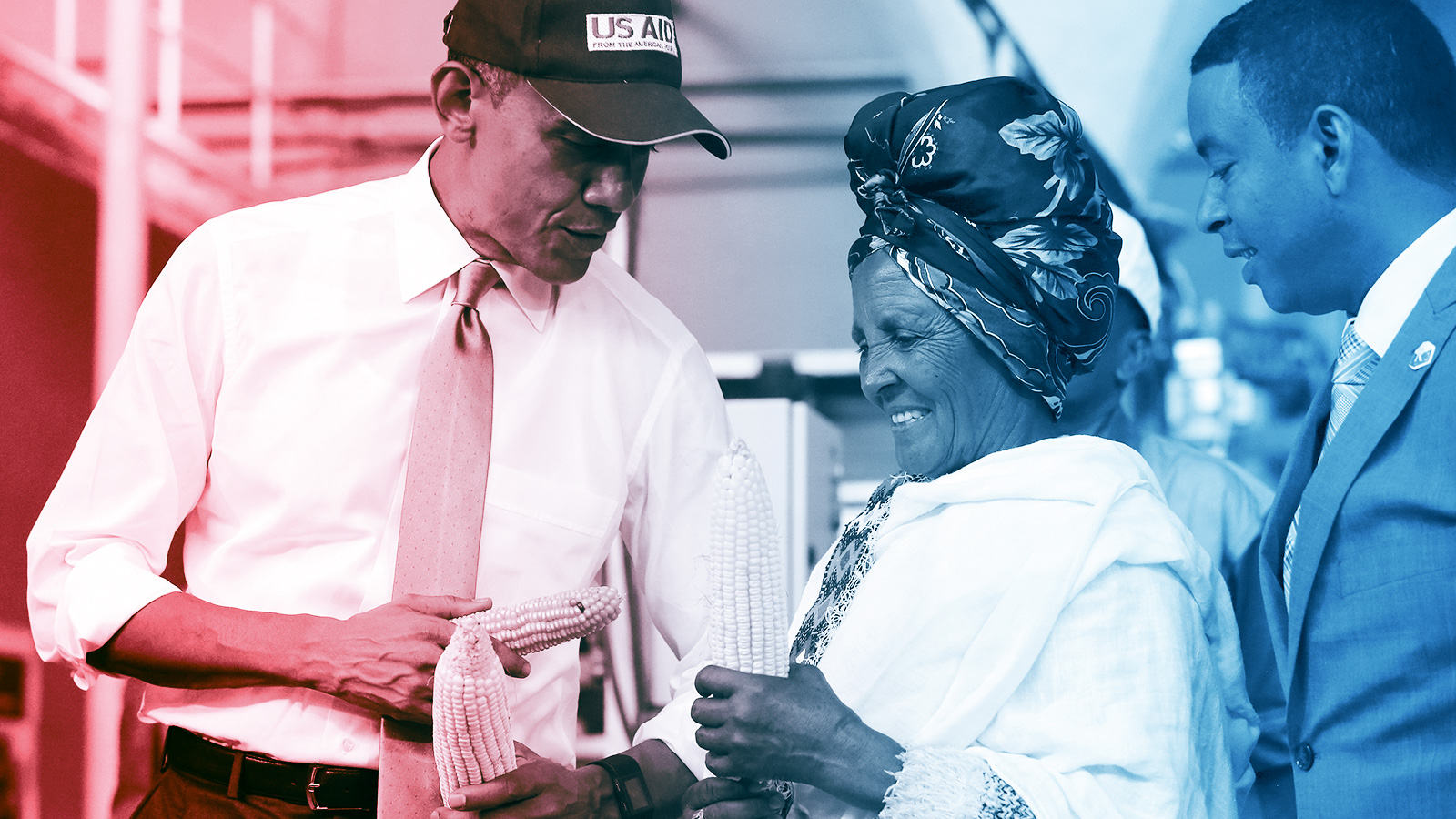The United States grows and consumes a lot of food — and how we do it matters. Our trade policies and foreign aid influence what farmers grow from Argentina to Zambia. Eating is the most profound way we affect the world; it takes a lot of land, labor, and energy to fill 7 billion bellies.
[grist-recirculation url=”/election-2016/” label=”Election Guide 2016: ” title=”Our experts weigh in on the real issues at stake in this election”]
Ignoring food policy would seed environmental and humanitarian disaster. But investing in food would yield a harvest of prosperity. It would spread the peace and stability that comes when people aren’t driven by desperation. Giving small farmers the tools, training, and seeds to help them make more money would also help them to grow a lot more food on less land, leaving more space for wilderness.
So how do we get it right? Here are some ways that our elected officials can help create and promote policies that push food in a more sustainable direction:
Invest in farm science
It takes years, and sometimes decades, to turn basic agricultural discoveries into widespread practice, so it’s crucial to start work long before we reach a crisis. But today, public funding for agricultural research stagnates while the population continues to grow and climate change makes farming more unpredictable.
Corporations have stepped into the breach to fund research and development. That’s good, but despite their marketing campaigns, they’re not primarily working in the public interest. It’s in corporations’ interest to serve the farmers with the most money and the most land. If we want science that meets the needs of the smallest, poorest, and most important farmers, we’ve got to pay for that with public money. That’s the role of government. But Congress allocates a paltry 4 percent of the budget for research and development. Back in the 1960s, it was nearly 12 percent. Can’t we get back to that?
Agricultural science also needs more attention. When kids think of cool science, they think of rockets, robots, and dinosaurs. Do they think of farming? Probably not.
But farm science is seriously cool. Think about the way plants talk to bacteria in the soil. Ponder the way genes lay out the blueprints for photosynthesis, and the way that explorers search out forgotten breeds to reinvigorate our food supply — it’s all magical. With a little money from our political leaders and a nudge from teachers, we could see a new generation of scientists burning with passion to make farming both bountiful and environmentally friendly.
Provide support for small farmers worldwide
In many cases, the tools and techniques that farmers need already exist. They just exist far from the farmers who need them most. International aid can bring the two together with dramatic results.
Consider the Ethiopian farmers I wrote about here. Birtukan Dagnachew Tegegn was a child bride whose husband died young and left her with four children and less than five acres of land, hours from the nearest road. By learning how to plant in rows rather than scattering seeds at random and other basic techniques, she dramatically boosted her crop yields. The extra money she received allowed her to send her children to school. Her eldest son recently earned his civil engineering degree. A little agricultural education can provide a path out of poverty.
Democrats and Republicans worked together this year to fund Feed the Future — the Obama initiative aiding small farmers abroad — through 2018. Congress should go further by passing legislation making this a 10-year commitment.
Give children a strong start
Stunting is the medical term to describe what happens when babies don’t get crucial nutrients. Stunted kids are permanently weaker, sicker, and less intelligent. This isn’t rare: 27 percent of children around the world suffer from it.
Some 4 percent of children in the United States are stunted. That’s 840,000 irreversibly damaged kids. What’s more, poor nutrition in the first 1,000 days is one of the main risk factors for obesity when children grow up.
If the humanitarian argument doesn’t move you, consider the economic one. Because this damage comes at the beginning of life, Americans wind up paying for 80 years (the average U.S. lifespan) worth of medical care and other social services for these babies. It’s much cheaper to give them a strong foundation. Americans also end up paying an indirect price through global instability when other countries struggle to take care of their children.
Give children a good start in their first 1,000 days, and it unlocks human potential. Invest in good nutrition for families and children become part of the force making a better world. It turns a problem into a solution.
U.S. policymakers should make nutrition counseling a standard part of pregnancy care and ensure that eligible mothers and babies sign up for food assistance (currently, only 63 percent of eligible people sign up for the Women, Infants, and Children nutrition program).
American women get a lot of medical support during pregnancy, but very little after birth. Let’s extend the period of medical surveillance to the full 1,000 days and make postnatal home visits a standard part of medical care, as is common in Europe. We should also provide a full day’s nutrition for low-income children in childcare here in the United States, increase our support for nutrition programs abroad, and encourage laws that protect breastfeeding everywhere.
Keep working on what’s next
The most pressing environmental and humanitarian problems of our time require solutions that directly address poverty. But there’s also a role for experimentation in food systems that serve the affluent and the middle class. In the long run, the innovations we come up with in the wealthier parts of the world will serve those who are catching up.
As the world grows more prosperous, there’s more demand for food that is both sustainable and beautiful — for farms that produce mouthwatering food while also making the landscape gorgeous. This is luxury agriculture, to be sure, but someday everyone may be able to afford to buy from farms that grow beauty well as calories.
Signals from leaders can help encourage this kind of innovation. When the Obamas dug a garden into the White House lawn, it was more than just a publicity stunt: By planting that garden, they showed the world that food production can be beautiful, and that this new wave in agriculture is worthy of attention.
But there’s a temptation to confuse what’s pretty with what’s sustainable. We have to make sure this next wave of farming is more environmentally friendly than what it’s replacing, otherwise it will simply become an empty affectation of the rich — Marie Antoinette’s farm reprised. The farms of the future should produce more food with fewer carbon emissions, less water pollution, and less land.
Finally, this innovation should continue beyond the farm, to improve the rest of the food chain. One way of doing that is to reduce the amount of food that’s wasted in supermarkets and in our homes. There’s already legislation in Congress that would provide some simple fixes — such as standardizing confusing “sell by” date labels. Politicians should pass that bill. By slashing food waste, the United States would take a small but important step toward a truly sustainable food system.




